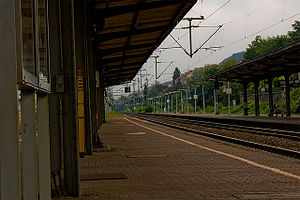
Bingen am Rhein is a town in the Mainz-Bingen district in Rhineland-Palatinate, Germany.

Bingerbrück is a Stadtteil of Bingen am Rhein, on the opposite side of the river Nahe from the old town of Bingen. It was self-administering until 1969.

Mainz Hauptbahnhof is a railway station for the city of Mainz in the German state of Rhineland-Palatinate. It is used by about 60,000 travelers and visitors each day and is therefore by far the busiest station in Rhineland-Palatinate. The station was a trial area for a CCTV scheme using automated face recognition.
Duisburg Hauptbahnhof is a railway station in the city of Duisburg in western Germany. It is situated at the meeting point of many important national and international railway lines in the Northwestern Ruhr valley.

Bonn Hauptbahnhof is a railway station located on the left bank of the Rhine along the Cologne–Mainz line. It is the principal station serving the city of Bonn. In addition to extensive rail service from Deutsche Bahn it acts as a hub for local bus, tram, and Stadtbahn services.
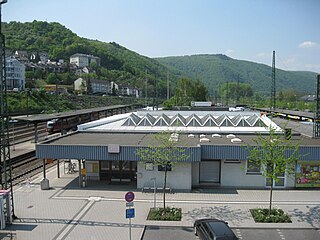
Bingen (Rhein) Hauptbahnhof is a railway station in the German city of Bingen am Rhein on the West Rhine Railway. It is located in the borough of Bingerbrück. The station that serves central Bingen is called Bingen Stadt.

Boppard Hauptbahnhof is a station in the town of Boppard in the German state of Rhineland-Palatinate. It is located on the outskirts of the town near the Rhine. It is at a railway junction on the West Rhine Railway between Köln Hauptbahnhof and Mainz Hauptbahnhof, and it is the starting point of the Hunsrück Railway (Hunsrückbahn) to Emmelshausen. It has three platform tracks.
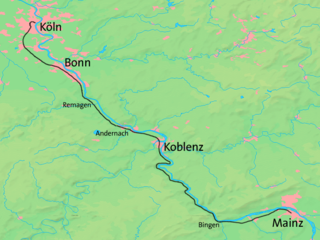
The West Rhine railway is a famously picturesque, double-track electrified railway line running for 185 km from Cologne via Bonn, Koblenz, and Bingen to Mainz. It is situated close to the western (left) bank of the river Rhine and mostly aligned to allow 160 km/h operation between Cologne and Koblenz and between Bingen and Mainz. Line speed between Koblenz and Bingen is restricted by the meandering nature of the Rhine Gorge, a UNESCO World Heritage Site.

Koblenz Hauptbahnhof is a railway station in the city of Koblenz in the German state of Rhineland-Palatinate. It is the focal point of rail transport in the Rhine-Moselle-Lahn area. It is a through station in southern Koblenz built below Fort Großfürst Konstantin and opened in 1902 in the Neustadt, which was built after the demolition of the city walls in 1890. The station replaced two former stations on the Left Rhine railway, which were only 900 m (3,000 ft) apart, and the former Moselle line station. Koblenz-Stadtmitte station opened in April 2011 in the old centre of Koblenz. Koblenz Hauptbahnhof is on the West Rhine Railway and connects to the Moselle line, the East Rhine Railway and to the Lahntal railway. It is used daily by about 40,000 travelers and visitors. In the station forecourt are a bus station and a pavilion.

Oberhausen Hauptbahnhof is a railway station in Oberhausen, North Rhine-Westphalia, Germany. The station was opened in 1847 and is located on the Duisburg–Dortmund railway, Arnhem-Oberhausen railway, Oberhausen–Duisburg-Ruhrort railway and Oberhausen-Mülheim-Styrum railway and is served by ICE, IC, RE and RB services operated by Deutsche Bahn, Abellio Deutschland, NordWestBahn and Eurobahn.

The Mainz–Worms–Ludwigshafen Railway connects Mainz via Worms to Ludwigshafen in the German state of Rhineland-Palatinate From there trains cross the Rhine via Mannheim or run south towards Speyer. It was opened in 1853 and is one of the oldest railways in Germany.

The Nahe Valley Railway is a two-track, partially electrified main line railway in the German states of Rhineland-Palatinate and Saarland, which runs for almost 100 kilometres along the Nahe. It was built by the Rhine-Nahe Railway Company and connects Bingen am Rhein on the Left Rhine line with Saarbrücken. It was opened between 1858 and 1860 and is one of the oldest railways in Germany. The section south of Bad Kreuznach is part of the regionally important transport corridor between the two major cities of Mainz and Saarbrücken.

Neustadt (Weinstr) Hauptbahnhof – called Neustadt a/d. Haardt until 1935 and from 1945 until 1950 – is the central station of in the city of Neustadt in the German state of Rhineland-Palatinate. In addition to the Hauptbahnhof, Rhine-Neckar S-Bahn services stop at Neustadt (Weinstr) Böbig halt (Haltepunkt). Mußbach station and Neustadt (Weinstr) halt, opened on 19 November 2013, are also located in Neustadt.
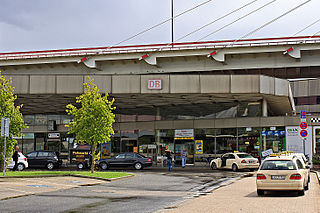
Ludwigshafen (Rhein) Hauptbahnhof is a railway station at Ludwigshafen am Rhein in the German state of Rhineland-Palatinate. A combination of a wedge-shaped station and a two-level interchange, the station is at the junction on the lines from Mainz and Neustadt an der Weinstrasse to Mannheim. It is classified by Deutsche Bahn as a category 2 station. The Ludwigshafen station was built in 1847 as a terminal station in the centre of modern Ludwigshafen. The current station was built in 1969 to the west of the city centre, but has not proved to be a success due to its poor location
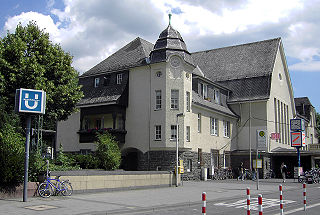
Bonn-Bad Godesberg station is on the Left Rhine line in the Bonn district of Bad Godesberg in the German state of North Rhine-Westphalia.

Weinheim (Bergstraße) Hauptbahnhof is a station in the town of Weinheim in the German state of Baden-Württemberg. It is served by Intercity services on the Main-Neckar Railway between Frankfurt and Heidelberg/Mannheim. The Weschnitz Valley Railway (Weschnitztalbahn) to Furth in the Odenwald starts at Weinheim station. There is also a freight railway to Viernheim, the last remaining section of the former Weinheim–Worms railway.

Bad Münster am Stein station is a station at a railway junction in Bad Münster am Stein-Ebernburg, a district of Bad Kreuznach in the German state of Rhineland-Palatinate. The station building, dating from about 1910, is protected as a monument. It is classified by Deutsche Bahn as a category 4 station. The station is located in the network of the Rhein-Nahe-Nahverkehrsverbund and belongs to fare zone 401. Its address is: Berliner Straße 20.
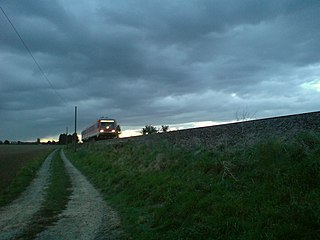
The Worms–Bingen Stadt railway or Rheinhessenbahn is a non-electrified line that links Worms via Alzey to Bingen Stadt in the German state of Rhineland-Palatinate.
Winnweiler station is the station of the town of Winnweiler in the German state of Rhineland-Palatinate. Deutsche Bahn classifies it as a category 6 station and it has two platforms.

St. Wendel station is the most important station in the town of St. Wendel in the German state of Saarland. The station is located at line-kilometer 106.3 of the Nahe Valley Railway (Nahetalbahn) and was the beginning of the now dismantled St. Wendel–Tholey railway. It was opened during the extension of the Nahe Valley Railway from Idar-Oberstein via Türkismühle to Neunkirchen (Saar) on 26 May 1860.
